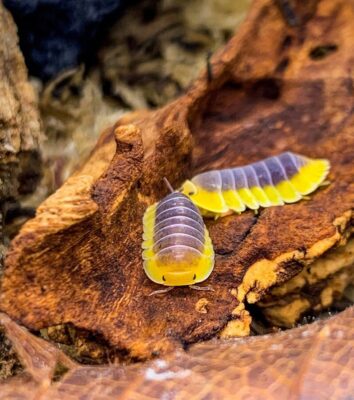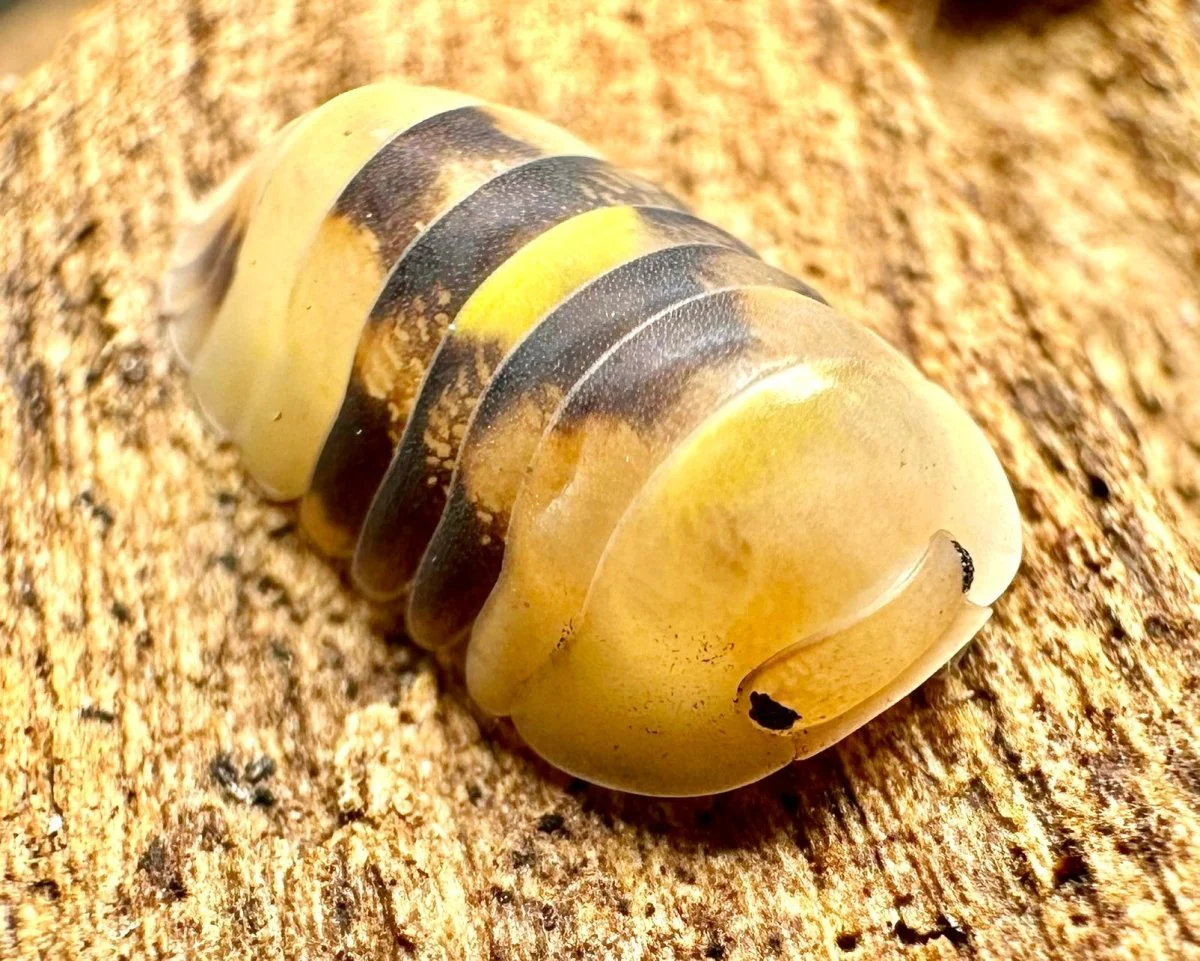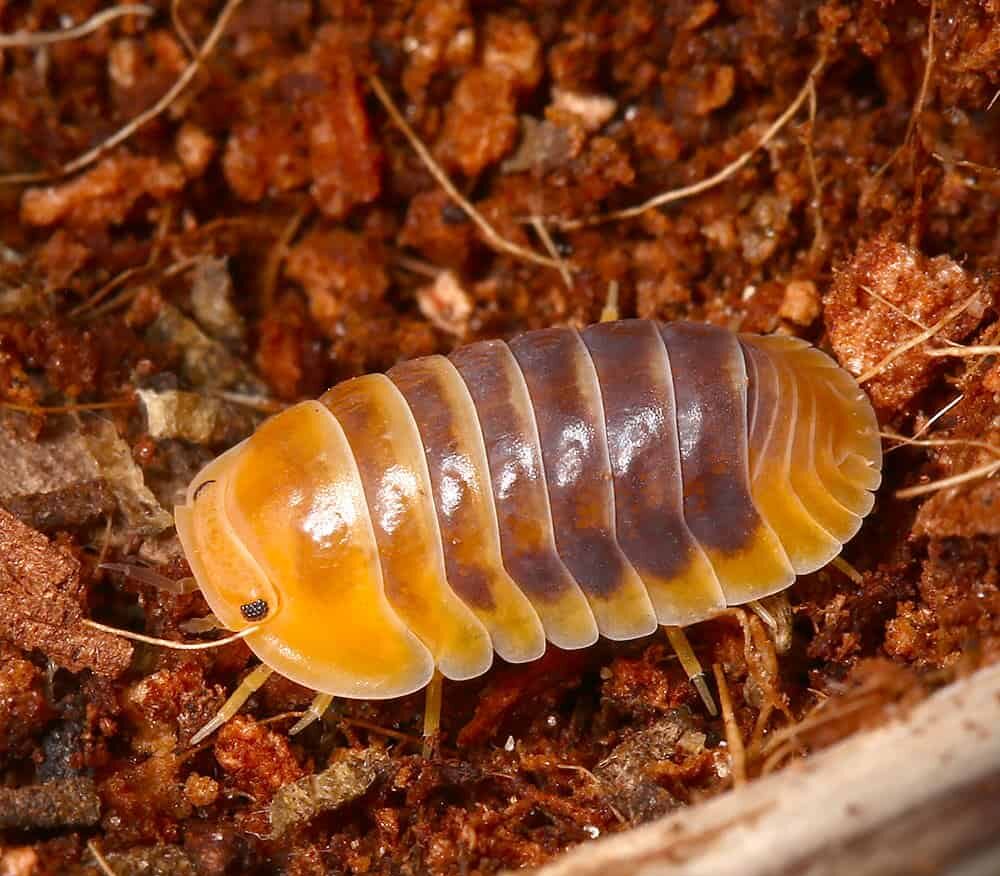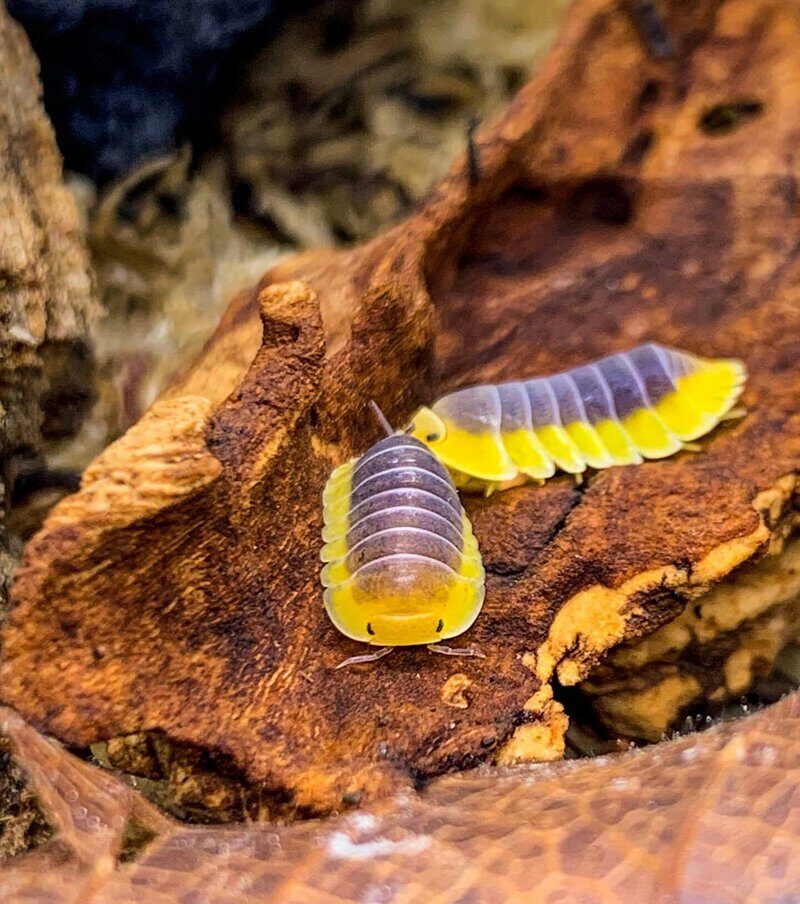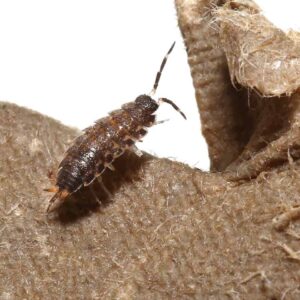Blue Lemon Isopod For Sale
$224.99
WE HAVE BLUE LEMON ISOPOD FOR SALE HERE ARE SOME HIGHLIGHTS:
Description
The blue lemon isopod, a unique and vibrant member of the crustacean family, continues to intrigue scientists and nature enthusiasts with its striking appearance and fascinating behaviors. Scientifically classified as Ligidium hypnorum, this small yet captivating creature belongs to the genus Ligidium and the species hypnorum. Its distinctive blue and yellow coloration sets it apart from other isopods, providing a visual allure that is both rare and mesmerizing.
This intriguing crustacean has piqued the interest of the scientific community due to its distinct physiological and ecological characteristics. The blue lemon isopod’s vibrant hues are not merely for show; they play a crucial role in its survival and interactions within its habitat. Researchers are particularly fascinated by its adaptive coloration, which serves as a form of camouflage and a warning signal to potential predators. These attributes make the blue lemon isopod a valuable subject in the study of evolutionary biology and ecological adaptations.
Beyond its scientific significance, the blue lemon isopod captivates nature enthusiasts with its unique behaviors and lifestyle. Found in moist, shaded environments, this crustacean exhibits a range of interesting behaviors that include burrowing, scavenging, and complex mating rituals. Observing these behaviors in their natural habitat provides insights into the intricate dynamics of ecosystem interactions and biodiversity.
In summary, the blue lemon isopod is much more than a colorful curiosity. Its scientific classification and ecological importance highlight the need for continued study and conservation efforts. By understanding the life and habits of such unique crustaceans, we gain a deeper appreciation for the complexities of nature and the delicate balance within ecosystems.
Physical Characteristics
The blue lemon isopod is an extraordinary crustacean, primarily recognized for its striking blue and yellow coloration. This vibrant appearance is not just an aesthetic trait but serves as a crucial adaptation in its natural habitat. The vivid blue hue, often compared to the color of a clear summer sky, covers most of its body, while the bright yellow accents adorn its legs and underbelly. This combination of colors can act as a form of warning coloration, deterring potential predators by signaling toxicity or unpalatability.
On average, the blue lemon isopod measures between 1.5 to 2 inches in length, making it a relatively small crustacean. Despite its size, it boasts a robust and segmented exoskeleton that provides both protection and flexibility. The isopod’s body is flattened dorsoventrally, allowing it to navigate through narrow crevices and beneath rocks easily. This physical adaptation is essential for both avoiding predators and hunting for food in its rocky coastal habitat.
Another distinctive feature of the blue lemon isopod is its antennae, which are long and segmented, contributing to its exceptional sensory capabilities. These antennae are critical for detecting food, mates, and potential threats. Additionally, their compound eyes, positioned on either side of their head, grant them a wide field of vision, enhancing their ability to spot predators and navigate their environment effectively.
The coloration of the blue lemon isopod also plays a significant role in camouflage. In their natural habitat, these isopods often reside in areas with ample blue and yellow-hued algae and corals. This environment allows them to blend seamlessly into their surroundings, thereby avoiding detection by both predators and prey. This combination of bright colors and physical adaptations highlights the intricate balance of form and function in the blue lemon isopod’s survival strategy.
Habitat and Distribution
The blue lemon isopod, a captivating member of the crustacean family, thrives in specific natural habitats that cater to its unique ecological needs. Primarily, these isopods are found in coastal marine environments, where they inhabit intertidal zones rich in both vegetation and organic matter. The intertidal zones provide the perfect blend of moisture and shelter, essential for their survival and proliferation. They often seek refuge under rocks, within crevices, and amidst decaying plant matter, which offer protection from predators and facilitate their detritivorous diet.
Geographically, the blue lemon isopod exhibits a relatively wide distribution, predominantly along temperate and tropical coastlines. They are most commonly sighted in regions such as the coastal areas of the Mediterranean, the Atlantic coasts of Europe and North America, and parts of the Indo-Pacific. These regions, characterized by their biodiversity and varying tidal patterns, create an ideal environment for the blue lemon isopod to flourish.
Several factors influence the habitat choices of the blue lemon isopod. Moisture levels are of paramount importance, as these isopods rely on a humid environment to maintain their physiological processes. Temperature also plays a significant role; they are typically found in areas where the temperature remains moderately warm, avoiding extreme cold or hot conditions. Furthermore, the availability of organic detritus and decaying matter is crucial for their sustenance, as it forms the primary component of their diet.
The blue lemon isopod’s ability to adapt to specific environmental conditions highlights its ecological versatility. Understanding the habitat and distribution of this intriguing crustacean not only provides insights into its ecological role but also underscores the importance of preserving coastal and marine ecosystems that support such unique species.
Diet and Feeding Habits
The blue lemon isopod, an intriguing marine crustacean, exhibits a diverse dietary palette that plays a critical role in its ecosystem. Predominantly, this isopod is a scavenger, meaning it primarily consumes decaying organic matter. This diet includes dead fish, plant detritus, and other decomposed marine organisms, helping to maintain the ecological balance by recycling nutrients back into the environment.
In addition to scavenging, the blue lemon isopod also feeds on algae and small invertebrates. This omnivorous feeding behavior allows it to adapt to varying food availability in its habitat. The isopod uses its sensitive antennae to detect food particles in the water and on the substrate. These antennae are equipped with chemoreceptors that can pick up chemical signals from potential food sources, making the blue lemon isopod an efficient forager.
One of the fascinating adaptations of the blue lemon isopod is its ability to consume food at varying depths of the ocean. This adaptability is facilitated by its robust digestive system, which can process a wide range of organic materials. Moreover, the isopod’s mandibles are well-developed and capable of breaking down tough plant fibers and animal tissues, contributing to its versatility in diet.
The blue lemon isopod’s feeding habits also have a significant impact on the marine ecosystem. As a scavenger, it contributes to the decomposition process, helping to clean the ocean floor and prevent the buildup of organic waste. By consuming algae, it helps to control algal growth, which in turn supports the health of coral reefs and other marine habitats.
Interestingly, the blue lemon isopod has been observed exhibiting social feeding behaviors. Groups of isopods can often be seen congregating around a large food source, displaying a degree of cooperation that enhances their feeding efficiency. This social aspect of their feeding behavior not only benefits the individuals but also underscores the complexity of their ecological role.
Reproduction and Lifecycle
The reproductive cycle of the blue lemon isopod is a captivating aspect of its biology. These isopods exhibit a unique mating behavior that begins with the male engaging in a series of intricate courtship displays. These displays often involve a combination of antennal movements and body posturing, designed to attract a receptive female. Once the courtship is successful, the male and female engage in copulation, which can last several hours, ensuring the transfer of sperm.
After fertilization, the female blue lemon isopod carries the fertilized eggs in a specialized brood pouch located underneath her body. This brood pouch provides a safe and protected environment for the developing embryos. The number of eggs can vary, but a typical clutch may contain anywhere from 20 to 50 eggs, depending on the female’s size and health.
As the embryos develop within the brood pouch, they undergo several molting stages. These stages are critical for their growth and development, as each molt allows the embryo to shed its exoskeleton and grow larger. The entire embryonic development process takes about two to four weeks, after which the young isopods, called mancae, emerge from the brood pouch.
The mancae resemble miniature adults but lack fully developed appendages and reproductive organs. They are independent from birth and undergo a series of molts as they grow. Each molt allows the young isopods to develop more complex and functional body structures. Throughout their lifecycle, blue lemon isopods go through approximately seven to nine molts before reaching full maturity, which can take around six months to one year, depending on environmental conditions and availability of food.
One unique reproductive strategy of the blue lemon isopod is their ability to reproduce asexually through a process called parthenogenesis. In this process, females can produce offspring without fertilization by a male. This strategy is particularly advantageous in environments where male isopods are scarce, ensuring the continuation of the species in less-than-ideal conditions.
Ecological Importance
The blue lemon isopod holds a significant position in its ecosystem, contributing to its overall health and stability. As a detritivore, this crustacean plays a crucial role in the decomposition process, breaking down organic matter and recycling nutrients back into the environment. This activity ensures the sustenance of soil fertility, which is vital for plant growth and the overall productivity of the ecosystem.
Moreover, the blue lemon isopod is an integral component of the food chain. It serves as a primary food source for various predators, including birds, amphibians, and small mammals. By providing nourishment to these higher trophic levels, the isopod supports biodiversity and helps maintain a balanced ecosystem.
The blue lemon isopod also engages in several symbiotic relationships that enhance its ecological significance. For instance, it often coexists with fungi and bacteria, which aid in the decomposition of organic materials. This mutualistic interaction not only benefits the isopod by providing it with a steady food supply but also facilitates the breakdown of complex organic compounds, accelerating nutrient cycling in the habitat.
Another fascinating aspect of the blue lemon isopod’s ecological role is its ability to help control the population of other small invertebrates. By preying on pests and competing with other detritivores, the isopod helps regulate species diversity and abundance, which is essential for preventing any single species from dominating the habitat.
Overall, the blue lemon isopod’s contributions to nutrient recycling, food web dynamics, and population control underscore its importance in maintaining environmental balance. Its presence within an ecosystem exemplifies the intricate interdependencies that sustain ecological health and biodiversity. Thus, preserving the blue lemon isopod is not only crucial for its survival but also for the continued vitality of its natural habitat.
Conservation Status
The conservation status of the blue lemon isopod is a subject of growing concern among marine biologists and environmentalists. This unique crustacean, known for its vibrant blue hue and intriguing behavior, is currently facing several threats that jeopardize its survival. One of the primary threats to the blue lemon isopod is habitat loss. Coastal development, pollution, and climate change are significantly altering marine ecosystems, leading to the degradation of the isopod’s natural habitat. Specifically, the destruction of coastal mangroves and coral reefs, which serve as vital habitats, has had a detrimental impact on their populations.
Pollution poses another major threat to the blue lemon isopod. The introduction of harmful chemicals and plastics into the ocean not only contaminates their habitat but also affects their food sources. Heavy metals and microplastics can accumulate in the isopod’s body, leading to health issues and reduced reproductive success. Furthermore, the warming of ocean waters due to climate change has resulted in altered distribution patterns and increased vulnerability to diseases, further endangering this species.
In response to these threats, several conservation efforts are being implemented to protect the blue lemon isopod. Marine protected areas (MPAs) have been established in regions known to harbor significant populations of this crustacean. These MPAs restrict human activities such as fishing and coastal development, thereby preserving the natural habitat and promoting population recovery. Additionally, initiatives aimed at reducing pollution, such as beach clean-ups and stricter regulations on waste disposal, are crucial in mitigating the adverse impacts on marine life.
Moreover, research and monitoring programs are essential for understanding the population dynamics and health of the blue lemon isopod. By studying their behavior, reproductive patterns, and responses to environmental changes, scientists can develop more effective conservation strategies. Public awareness campaigns also play a vital role in garnering support for conservation efforts, emphasizing the importance of protecting this fascinating species and its habitat.
Interesting Facts and Research
The blue lemon isopod, scientifically known as Armadillidium klugii, is a unique species of terrestrial isopod that has captivated the interest of scientists and nature enthusiasts alike. One remarkable characteristic of the blue lemon isopod is its vibrant coloration. Unlike most isopods that exhibit muted tones, this species boasts a striking blue and yellow pattern, which serves as both camouflage and a warning to potential predators.
Recent research has shed light on the blue lemon isopod’s intriguing survival strategies. A study conducted by marine biologists at the University of California revealed that these isopods possess a highly developed ability to adapt to various environmental conditions. This adaptability is attributed to their robust exoskeleton and the ability to enter a state of dormancy during unfavorable conditions. Such features not only enhance their survival rates but also make them a model organism for studying resilience in invertebrates.
Additionally, genetic studies have uncovered fascinating insights into the blue lemon isopod’s evolutionary history. Researchers have found that this species diverged from its closest relatives approximately 30 million years ago, a period marked by significant climatic shifts. This long evolutionary history has equipped the blue lemon isopod with a unique set of genes that contribute to its distinctive coloration and survival mechanisms.
Looking towards the future, scientists are keen to explore several avenues of research related to the blue lemon isopod. One area of interest is the potential application of their dormant state in biotechnology. Understanding the molecular mechanisms behind this ability could pave the way for innovations in preserving biological tissues and organs. Moreover, further investigation into their genetic makeup could provide deeper insights into the evolution of crustaceans and the ecological roles they play in their habitats.
Ongoing and future research promises to reveal even more about the blue lemon isopod, solidifying its status as a fascinating subject of study within the scientific community.
